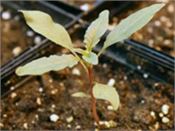|
New Gene For Atrazine Resistance Identified In Waterhemp
• Waterhemp, a common agricultural weed, has become increasingly resistant to atrazine and other herbicides.
• Waterhemp uses a class of enzymes known as GSTs to detoxify herbicides, but the exact GST responsible for atrazine resistance was not known until recently.
• University of Illinois researchers used molecular methods to identify a gene for GST-based atrazine resistance.
• Knowledge of the gene will allow for easier diagnosis and could lead to the development of more targeted control options.
URBANA, ILL.
Waterhemp has been locked in an arms race with farmers for decades. Nearly every time farmers attack the weed with a new herbicide, waterhemp becomes resistant to it, reducing or eliminating the efficacy of the chemical. Some waterhemp populations have evolved resistance to multiple herbicides, making them incredibly difficult to kill.
Adding to the challenge is the fact that waterhemp can evolve resistance in at least two ways. In target-site resistance, a gene mutation changes the protein that the herbicide is designed to attack. With an ill-fitting protein binding site, the herbicide becomes ineffective. The plus side of target-site resistance is that it is relatively easy to identify using standard lab procedures.
Metabolic resistance is a different beast. Plants use any one of hundreds of possible enzymes to detoxify the chemical, rendering it useless. Although University of Illinois weed scientists Dean Riechers, Rong Ma, and Josh Skelton recently developed a quick and easy test for metabolic resistance, they still had no way of knowing which enzyme was responsible.
Until now.
“We think we found the needle in the haystack,” Riechers says.
Riechers and his colleagues focused on metabolic resistance to atrazine, a chemical that has been used for decades and is still sprayed on approximately 80 percent of the corn acreage in the United States, despite increasing resistance and concerns about environmental impacts.
From previous research at U of I, the team knew that resistant waterhemp metabolizes atrazine with a class of enzymes known as GSTs. “Plants are known to have anywhere from 50-120 GST genes. We wanted to know if resistance was coming from just one of those, and whether we could find it,” Riechers says.
Former graduate student Anton Evans isolated candidate GST proteins from waterhemp and looked at their expression in resistant and sensitive plants. One of the GST proteins was extremely abundant in resistant plants, but almost nonexistent in sensitive plants. Graduate student Sarah O’Brien looked more closely at the gene encoding that GST protein, and, in particular, at its variants or alleles. She noticed that when two dominant alleles for this gene were present, it took more than 14 times the recommended atrazine rate to damage the plants.
“The heterozygous plants – those with just one copy of the dominant allele – had much higher injury. In an experiment with four or five heterozygous plants, two or three would die and the others were stunted and had a lot of dead tissue. But the homozygous resistant plants – those with two copies of the dominant allele – almost looked like they hadn’t been sprayed,” O’Brien says.
“Plants without the dominant allele just got hammered, even at low herbicide application rates,” Riechers adds.
This evidence, along with more detailed molecular data, gives the team confidence that they have discovered something unique. “This may be the only case where we’ve actually found the gene responsible for metabolic resistance in a broadleaf weed, as opposed to target-site resistance,” Riechers explains, “for any herbicide.”
Going forward, the test for this gene will be similar to the test for target-site atrazine resistance. The new information also could be used by industry to develop new chemicals to control waterhemp.
“As long as we know the gene, you could potentially knock it out and make the plant sensitive again. You could design a GST-inhibiting chemical that’s specific to this one GST,” Riechers says. ∆

|
|